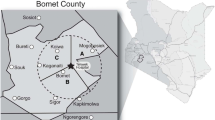Abstract
In this work, we report on a relationship between urinary selenium and the development of cervical uterine cancer. A simple chemical method was developed to concentrate trace amounts of selenium from relatively large urine samples by use of small activated carbon filters. When these filters are irradiated with thermal neutrons, selenium can be determined either by 77mSe (t 1/2=17.5 s) or 75Se (t 1/2=120 d). In this article, we report the results for 82 urine samples from women with cervical uterine cancer in several stages of development and from healthy controls. These results show a statistically significant increase of selenium excretion in cancer patients as compared to controls. Urinary selenium excretion is highest for patients in the intermediate stages of the disease.
Similar content being viewed by others
References
M. Simonoff and G. Simonoff, Le sélénium et la vie, Masson, Paris (1991).
G. N. Schrauzer, Selenium, mechanistic aspects of anticarcinogenic action, Biol. Trace Element Res. 33, 51–62 (1992).
A. N. Garg, V. Singh, R. G. Wegingwar, and V. N. Sagdeo, An elemental correlation study in cancerous and normal breast tissue with successive clinical stages by neutron activayion analysis, Biol. Trace Element Res. 46, 185–194 (1994).
M. Gerber, S. Richardson, R. Salked, and P. Chappuis, Antioxidants in female breast cancer patients, Cancer Inv. 9, 421–428 (1991).
M. M. El-Sharabasy, I. El-Dosaky, H. Horria, and A. H. Khalaf, Elevation of glutathione reductase and nucleic acids in both normal tissues and tumour of breast cancer patients, Cancer Lett. 72, 5–11 (1993).
J. M. Navarrete, Analyse par activation du selenium dans des échantillons biologiques, en utilisant une méthode de pre-séparation des traces, Ph.D. thesis, Universite Paris VI (1992).
M. Navarrete, L. Cabrera, N. Deschamps, N. Boscher, G. Revel, and A. Stampfler, Activation analysis of Se in biological samples through Se77m, J. Radioanal. Nucl. Chem. Lett. 145(6), 445–452 (1990).
M. Navarrete, L. Cabrera, N. Deschamps, N. Boscher, G. Revel, J. P. Meyer, et al., Activation analysis of Se in organic samples, through Se-77m on a pre-separation basis, J. Radioanal. Nucl. Chem. Art. 168(1), 15–21 (1993).
M. Navarrete, L. Cabrera, T. Martínez, G. Revel, J. P. Meyer, and A. Stampfler, Activation analysis of selenium in cancer research, J. Radioanal. Nucl. Chem. Art. 195, 91–95 (1995).
M. Navarrete, L. Cabrera, T. Martínez, G. Revel, J. P. Meyer, and J. Guarner, Relationship between the cervical uterine cancer evolution and selenium concentration in urine determined by NAA, J. Radioanal. Nucl. Chem. Art. 217, 167–169 (1997).
Author information
Authors and Affiliations
Rights and permissions
About this article
Cite this article
Navarrete, M., Gaudry, A., Revel, G. et al. Urinary selenium excretion in patients with cervical uterine cancer. Biol Trace Elem Res 79, 97–105 (2001). https://doi.org/10.1385/BTER:79:2:97
Received:
Revised:
Accepted:
Issue Date:
DOI: https://doi.org/10.1385/BTER:79:2:97




